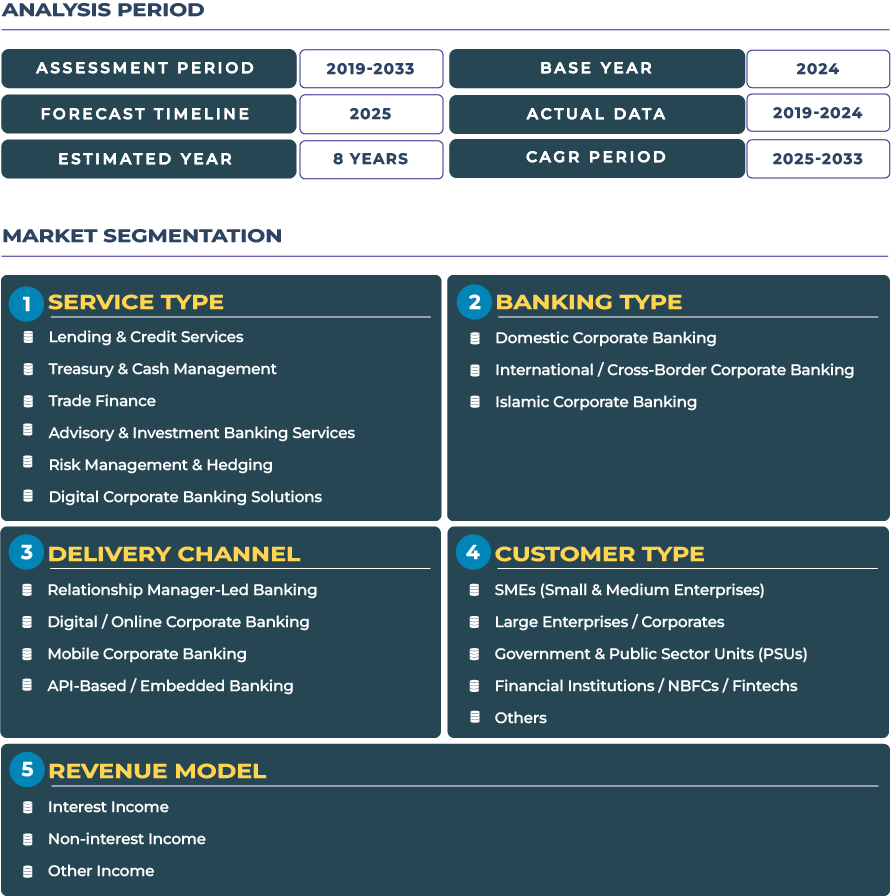SME-Centric Digital Treasury Transformation Defining Taiwan Corporate Banking Evolution
Taiwan corporate banking market is undergoing measurable transition as banks prioritize digital treasury capabilities and SME-focused lending platforms. With a high concentration of small and medium-sized enterprises driving regional exports, domestic financial institutions are integrating cloud-based cash management, online credit evaluation tools, and automated FX hedging services. This market shift reflects a broader nationwide priority to boost liquidity visibility, improve trade finance accessibility, and enhance working capital cycles across manufacturing clusters. Supported by a robust digital infrastructure and policy backing, Taiwanese banks are redefining how corporate transactions, receivables, and short-term financing are managed across sectors.
Note:* The market size refers to the total revenue generated by banks through interest income, non-interest income, and other ancillary sources.
From an overall market standpoint, the Taiwan corporate banking industry is projected to grow from USD 26.2 billion in 2025 to USD 36.7 billion by 2033, registering a CAGR of 4.3%. This trajectory is backed by semiconductor supply chain integration, heightened FX activity, and increasing adoption of digital corporate banking solutions among SMEs and mid-sized industrial firms. With geopolitical tensions in East Asia and supply chain realignments influencing capital requirements, Taiwanese institutions are investing in resilience-focused treasury management, risk-mitigated financing, and trade-driven liquidity products that align with rapid export cycles. Companies seeking a dependable corporate banking ecosystem are leveraging real-time payment solutions, structured receivables discounting, and integrated advisory services to navigate volatile cross-border environments.
Export Supply Chains and FX-Driven Corporate Lending Create Strong Market Tailwinds
One of the major market accelerators is the rise in financing demand from high-tech export industries such as semiconductors, electronics assembly, and contract manufacturing. Corporates increasingly rely on trade finance, receivables discounting, and cross-border hedging tools to manage global shipment schedules and FX fluctuations. The proliferation of digital credit evaluation across SME suppliers has improved working capital access and shortened deal cycles, strengthening the link between banks and export ecosystems. Treasury and cash management platforms now incorporate dynamic liquidity tracking and collection automation to support procurement flows.
Large manufacturers continue to lead in treasury digitization, creating downstream demand for financing solutions among tiered suppliers. Banks are crafting supply chain finance programs that align with procurement calendars for OEMs and electronic manufacturing service providers. Additionally, corporates with offshore subsidiaries seek risk management and short tenure lending instruments to manage cyclical capital requirements. These factors contribute to more diversified growth in the corporate banking landscape, beyond traditional asset-based lending.
Market Complexity Tied to Sector Concentration and Global Mandate Limitations
Despite a strong growth outlook, the Taiwan corporate banking sector faces structural limitations. A significant portion of corporate credit and treasury demand is concentrated around the semiconductor and electronics sectors, increasing systemic exposure to global semiconductor cycles. Domestic institutions, though technologically adept, face challenges scaling global mandates and deploying large-ticket financing products at internationally competitive pricing. Smaller banks often struggle to match the global service footprint offered by international institutions.
Corporate group cross-guarantee frameworks also introduce compliance and collateral complexities, particularly for multi-entity holdings. Capital adequacy requirements and evolving risk models can restrict aggressive lending in export-heavy portfolios. These constraints occasionally slow down the pace of new product rollout and limit broader SME inclusion. Nonetheless, financial regulators such as the Financial Supervisory Commission continue encouraging digital compliance and credit scoring innovation that can reduce friction in securing structured finance.
Semiconductor Treasury Integration and Receivables Financing Lead Emerging Trends
Taiwan’s leading corporate banking trends reflect a robust alignment with industrial supply chains. Integration into the semiconductor treasury network has encouraged banks to craft dynamic credit lines and cash pooling solutions tailored to international vendor contracts. Export receivables financing has gained traction as a strategic instrument to manage working capital cycles, especially among mid-tier component suppliers. Banks are expanding partnerships with contract electronics manufacturers to synchronize payment schedules with high-volume procurement cycles.
Collaborations between banks and electronics manufacturing service providers enable liquidity solutions that plug directly into ERP platforms. These arrangements reduce manual reconciliation and improve transaction transparency between local suppliers and global buyer networks. Additionally, the increase in cross-platform trade finance instruments has opened pathways for banks to structure onshore-offshore liquidity corridors that support exporters across Asia Pacific.
Opportunities in Supply Chain Finance, Discounting, and Digital Integration
As supplier finance gains momentum, corporate banks are investing in dedicated financing desks to serve semiconductor clusters and their satellite industries. Export receivables discounting is emerging as a competitive differentiator, allowing corporates to accelerate cash conversion cycles and reduce funding costs. ERP-to-bank integration is another high-potential growth area, providing automated transaction visibility and facilitating treasury centralization.
Banks are also expanding cash flow management services for SMEs, offering digital dashboards and credit-linked treasury tools to meet rising operational demands. This opens new avenues in structured credit services, dynamic invoicing, and integrated collection systems, making banks essential partners in enterprise growth. Overall, these opportunities enable Taiwanese corporate banking institutions to evolve from transactional service providers into strategic liquidity partners.
Competitive Strategies Led by Domestic and International Institutions
Taiwan’s major corporate banking entities are implementing specialized solutions to meet sector-specific demands. CTBC Bank has expanded digital platforms targeting SME exporters with integrated FX and trade finance services. Central Bank of the Republic of China (Taiwan) continues promoting secure interbank digital transactions that support large corporate transfers. The Chinese National Association of Industry and Commerce plays a key role in strengthening bank-industry collaboration and financing strategy advocacy.
Recent competitive strategies include building semiconductor supplier finance desks tailored to procurement-led credit demands. Banks are also offering export receivables discounting products for component makers to mitigate payment delays. ERP banking connectors, which embed digital reconciliation within enterprise operations, are being adopted by institutions seeking to improve cross-border transaction transparency. These strategic advancements reinforce competitiveness in both domestic and international corporate finance environments.







